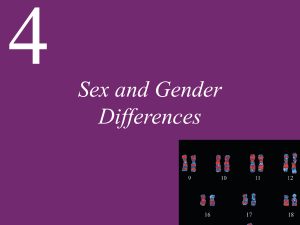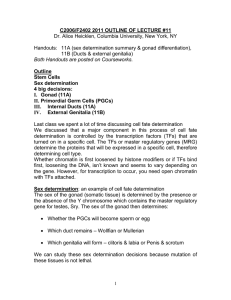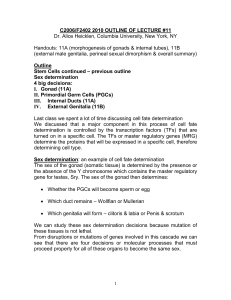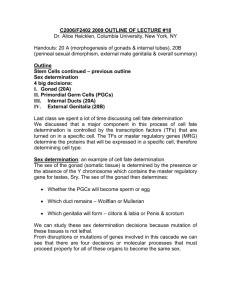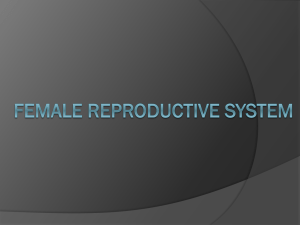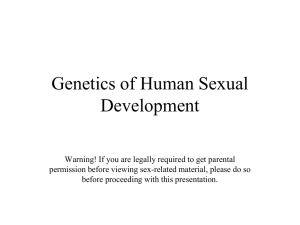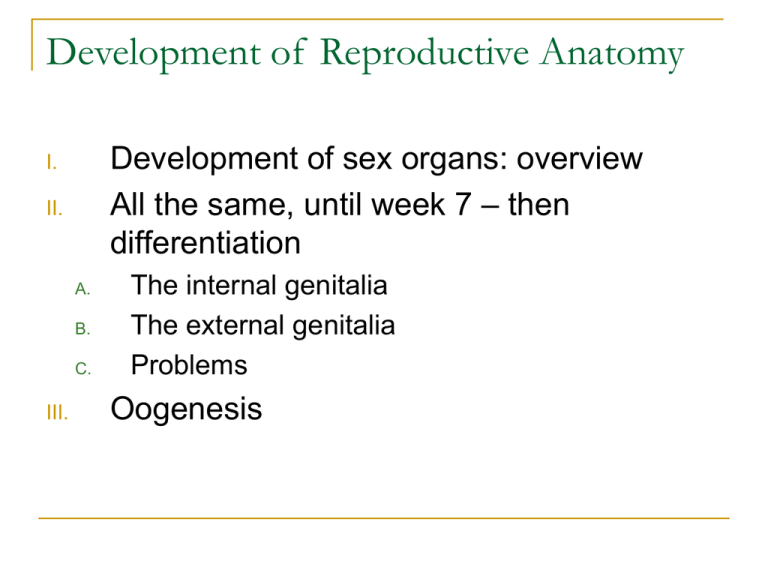
Development of Reproductive Anatomy
Development of sex organs: overview
All the same, until week 7 – then
differentiation
I.
II.
A.
B.
C.
III.
The internal genitalia
The external genitalia
Problems
Oogenesis
Development of sex organs: overview
Sex determination occurs first in the gonads
and is followed by appropriate development
of the ducts, glands and associated genitalia.
In the absence of testis-determining genes,
the gonadal primordium develops as an ovary
I. All the same, until week 7
Sexually indifferent stage: By 6-7 weeks of
fetal life, fetuses of both sexes have two
sets of internal ducts, the Mullerian (female)
ducts and the Wolffian (male) ducts.
Gonad differentiation: female – ovaries
Mammalian gonad forms within the developing urogenital system, which
itself derives from the intermediate mesoderm.
Epithelial structures are shown in red, mesenchymal structures are shown in blue,
and the striped region denotes the genital ridge. (WD) Wolffian duct; (MT)
mesonephric tubules; (MD) Mullerian duct; (UB) ureteric bud; (CE) coelomic
epithelia.
A. Development of the internal structures
1)
Gonadal ridge (masses of mesoderm) form
buldges on the dorsal abdominal wall just
medial to the mesonephros
2). Primordial germ cells become associated with finger-like
processes produced by proliferation of the mesothelium, the primary
sex cords.
3) Further development of the
primary sex cords results in
differentiation of an outer cortex and
inner medulla.
The medulla disappears in females
and the cortex develops into the
ovary.
4) The paramesonephric
ducts differentiate into
The mesonephric ducts degenerate.
The paramesonephric ducts come together in the
median plane and fuse into the uterovaginal
primordium.
The dilated free ends of the tubes open into what will
eventually be the peritoneal cavity.
The uterovaginal primordium invaginates the dorsal
surface of the urogenital sinus to become the
epithelium and glands of the uterus.
The fallopian tubes form from the unfused portions of
the paramesonephric ducts.
B. The external genitalia
The external genitalia arise from the same
structures in both sexes –
At 8 weeks the external structures appear
include a genital tubercle, the genital folds,
urethral folds and a
Genital tubercle gives rise to the clitoris and
the urethral groove persists as the vestibule.
The unfused utrethral folds become the labia
minora.
Development review
two products of the developing testes are
needed for normal male development.
In the female, absence of androgens permits
the external genitalia to remain feminine
C. Hormonal imbalance results in variation:
Any interference with the normal pattern of
sex hormone production in the embryo
If testes do not produce testosterone – XY
If testes do not produce AMH, both female
and male duct systems form, but the external
genitalia are male
If XX is exposed to testosterone –
Psuedohermaphroditism
1.
•
•
2.
•
Androgen insensitivity syndrome (AIS)
If the testes form only partially and the production of
androgen and Mullerian inhibitor is incomplete, there will
be only partial masculinization of the external genitalia as
well as incomplete inhibition of development of the vagina,
uterus and Fallopian tubes.
If the testes form normally but are enzymatically incapable
of completion of testosterone metabolism, there will be
failure of complete masculinization of the external
structures. However, the inhibition of Mullerian ducts will
be normal because of normal production of Mullerian
inhibitor, and therefore the upper vagina, uterus and
Fallopian tubes may be absent.
Congenital adrenal hyperplasia
The androgen from the adrenal causes masculinization of
the external genitalia, but since there is no Mullerian
inhibitor, a normal uterus and vagina will develop
Psuedohermaphrodites – individuals with accessory
reproductive structures that do not “match” their gonads
True hermaphrodites – rare, possess both ovaries and
testicular tissue
CAH
AIS
Genetic imbalance due to nondisjunction
Sex-chromosome differences more frequent than
autosomal abnormalities:
X inactivation
Y contains few functional genes
XO – Turner syndrome (female)
YO
XXX – Trisomy X (female)
XXXX
XXY – Klinefelter syndrome (male)
XYY – Double Y (male)
Klinefelter Syndrome
Turner Syndrome
Production of haploid gametes is
essential for sexual reproduction
III. Oogenesis
A. Differentiation of the ovum
Forms a gamete that contains all the factors needed to
initiate and maintain metabolism and development (as
compared to simple sperm)
Haploid nucleus
Cytoplasmic enzymes
mRNAs
organelles
metabolic substrates
gametes develop from primordial germ cells that
migrate to the somatic gonadal precursors (genital ridges
in mammals) same for drosophila, xenopus & zebrafish
once the gonad is assembled, germ cells begin active
proliferation and become gonial cells.
B. Follicle formation
In all species except C. elegans, gonadal
somatic cells envelop female germ cells to
create a follicle
Primordial Germ cells destined to become
oocytes have already entered meiosis at the
time of follicle formation and within the follicle
they reach the diplotene stage of PI – here
they halt meiosis for a few days to many
years, depending on the species
Mechanisms of oogenesis differ among taxa
because reproduction patterns also vary
Synchronous development leads to "cohorts" of eggs which
are in the same stage of development, which reach maturity at
the same time, and which are spent all at once.
Hence, synchroneous gonad development is a cyclical affair: The
gonad grows in size and mass during the ripening of the eggs
until a distinct spawning event occurs which sets the gonad
back to the initial conditions of the cycle
In the gonads of species with asynchronous development we
will not find "cohorts" of eggs being in the same stage of
development, but there are eggs of any develop-mental stage at
any time.
These species show no distinct spawning times, but more or less
continuous spawning all year round.
1). In Drosophila, asymmetric cell division
gives rise to the oocyte
Cystoblast undergoes 4 mitotic divisions to give rise to a
cyst of 16 germline cells
http://berglab.gs.washington.edu/movies/cy2xGFPmoe.qt
2). Oogenesis in Vertebrates
Cyst phase is confined to early ovarian
development and cells in an individual cyst
do not differentiate as nurse cells
Egg asymmetry
it is during oogenesis that the animal-vegetal
axis of the egg is specified.
as a result of differential intracellular
transport, the amount of yolk steadily
increases in the vegetal hemisphere
Oogenesis in Xenopus Iaevis
Oogonia are found as nests of 16 pearl
shaped cells that develop synchronously
Growth of oocytes in the frog. During the first 3 years of life, three cohorts of oocytes
are produced. The drawings follow the growth of the first-generation oocytes.
The large cell in the picture above is either the product of the first or second meiotic
division that lives.
Follicular growth stage & antrum
formation
Ooctye undergoes
increase in # of follicular granulosa cells
Cavity forms (antrum) which fills with
proteins, hormones & additional molecules
Follicle cells secrete growth & differentiation
factors
The ovarian follicle of mammals. (A) Maturation of the ovarian follicle. When
mature, it is often called a Graafian follicle. (B) Scanning electron micrograph of
a mature follicle in the rat.
Ovulation in the rabbit.

